What Not to Bring on Vacation
Packing for your next vacation or day in the sun? The Environmental Working Group (EWG) believes these items should never make it into your suitcase, beach bag or backpack.
- No Spray Sunscreens
- No Super-High SPFs
- No Oxybenzone
- No Loose Powder Sunscreens
- No Retinyl Palmitate
- No Combined Sunscreen/Bug Repellents
- No Sunscreen Towelettes
- No Tanning Oils
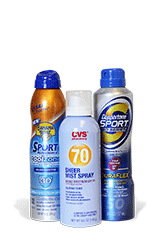
1) No Spray Sunscreens
Given the ease of applying them on squirming kids and hard-to-reach areas, these super-popular aerosolized sunscreens may seem like a dream come true. But there’s growing concern that these sprays pose serious inhalation risks. They also make it too easy to apply too little or to miss a spot, leaving bare skin exposed to harmful rays.
Even though the Food and Drug Administration expressed concern in 2011 about the safety and efficacy of spray sunscreens, companies continue to turn them out. One in every four beach and sport products in our 2013 sunscreen report are sprays. They’re found in products such as:
CVS Sheer Mist Sunscreen, SPF 70
Coppertone Sport Pro Series Clear Continuous Spray Sunscreen, SPF 50
Banana Boat Sport Performance CoolZone Continuous Spray Sunscreen, SPF 30
Coppertone Sport Pro Series Clear Continuous Spray Sunscreen, SPF 50
Banana Boat Sport Performance CoolZone Continuous Spray Sunscreen, SPF 30
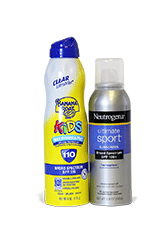
2) No Super-High SPFs
Products with sky-high SPFs may protect against sunburn but could leave your skin exposed to damaging UVA rays.
Although the letters SPF stand for “sun protection factor,” this refers only to protection against UVB radiation, which burns the skin. It has nothing to do with the sun’s UVA rays, which penetrate deep into the skin, suppress the immune system, accelerate skin aging and may cause skin cancer.
One in seven of the sunscreens in EWG’s sunscreen guide this year boasts SPFs higher than SPF 50+. These high-SPF products may tempt people to stay in the sun too long, suppressing sunburns but upping the risk of other kinds of skin damage. The FDA is considering limiting SPF claims to 50+, as is done in other countries. Capping SPF ratings would cut down on the false sense of security that higher numbers can impart.
EWG recommends that consumers avoid products labeled with anything higher than SPF 50+ and reapply sunscreen often, regardless of SPF. Some high-SPF products:
Banana Boat Kids MAX Protect & Play Continuous Spray Sunscreen, SPF 110
Neutrogena Ultimate Sport Spray Broad Spectrum Sunscreen, SPF 100+
Neutrogena Ultimate Sport Spray Broad Spectrum Sunscreen, SPF 100+
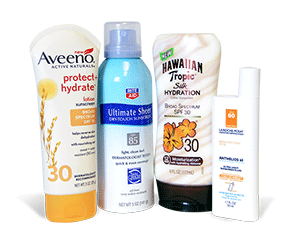
3) No Oxybenzone
Commonly used in sunscreens, the chemical oxybenzone penetrates the skin, gets into the bloodstream and acts like estrogen in the body. It can also trigger allergic reactions. Data are preliminary, but studies have found a link between higher concentrations of oxybenzone and health harms. One study has linked oxybenzone to endometriosis in older women; another found that women with higher levels of oxybenzone during pregnancy had lower birth weight daughters.
Nearly half of all beach and sport sunscreens in this year’s guide contain oxybenzone, including:
Rite Aid Ultimate Sheer Dry-Touch Sunscreen, SPF 85
La Roche-Posay Anthelios 60 Face Ultra Light Sunscreen Fluid, SPF 60
Hawaiian Tropic Silk Hydration Lotion Sunscreen, SPF 30
Aveeno Active Naturals protect + Hydrate Lotion Broad Spectrum Sunscreen, SPF 30
La Roche-Posay Anthelios 60 Face Ultra Light Sunscreen Fluid, SPF 60
Hawaiian Tropic Silk Hydration Lotion Sunscreen, SPF 30
Aveeno Active Naturals protect + Hydrate Lotion Broad Spectrum Sunscreen, SPF 30
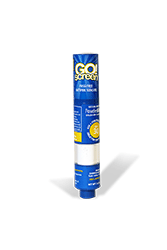
4) No Loose Powder Sunscreens
Loose powder sunscreens are designed to be used on the face and scalp. They often contain tiny particles of zinc and titanium that can potentially offer strong UV protection if enough sticks to the skin. But they end up in the lungs, too, inhaled from a cloud of airborne particles each time they’re applied. There, they can cause damage. Based on studies of rats and people who work in dusty environments, the International Agency for Research on Cancer classifies inhaled titanium dioxide as “possibly carcinogenic to humans.” Tiny zinc particles also irritate the lungs and could pass through skin into the body.
FDA’s current over-the-counter rules no longer allow loose powders, including loose powder makeup, to advertise an SPF or make claims of sun protection. But it granted small companies an extra year to remove their powders from the market.
The bottom line? If there’s a chance you’ll breathe it, don’t buy it. EWG recommends that people stick to creams and avoid powders and sprays such as:
Go!screen Natural Mineral Powder Block Brush-on Sunscreen, SPF 30
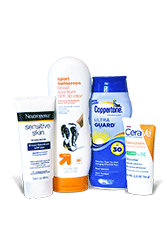
5) No Retinyl Palmitate
When used in a night cream, this form of vitamin A is supposed to have anti-aging effects. But on sun-exposed skin, retinyl palmitate may speed development of skin tumors and lesions, according to government studies. Why is this “inactive ingredient” allowed in sunscreens intended for use in the sun? Good question.
The FDA has yet to rule on the safety of retinyl palmitate in skin care products, but EWG recommends that consumers avoid sunscreens containing this chemical.
Almost one in four of the SPF-rated sunscreens, makeups and moisturizers in this year’s guide contains retinyl palmitate, including:
Up & up Sport Sunscreen Lotion, SPF 30
Coppertone UltraGuard Sunscreen Lotion, SPF 30
CeraVe Body Lotion Broad Spectrum Sunscreen, SPF 50
Neutrogena Sensitive Skin Broad Spectrum Sunscreen Lotion, SPF 60+
Coppertone UltraGuard Sunscreen Lotion, SPF 30
CeraVe Body Lotion Broad Spectrum Sunscreen, SPF 50
Neutrogena Sensitive Skin Broad Spectrum Sunscreen Lotion, SPF 60+
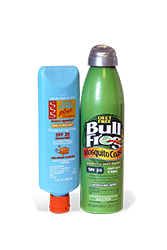
6) No Combined Sunscreen/Bug Repellents
Skip products that combine bug repellent with sunscreen. Why? For starters, bugs are typically not a problem during the hours when UV exposure peaks. Also, sunscreen may need to be reapplied more frequently than repellent, or vice versa. We recommend that you avoid using repellents on your face, too. Studies indicating that combining sunscreens and repellents leads to increased skin absorption of the repellent ingredients.
EWG recommends that you skip products like:
Bull Frog Mosquito Coast Sunscreen with Insect Repellent, SPF 30
Avon Skin-So-Soft Bug Guard Plus, Cool ‘n Fabulous, SPF 30
Avon Skin-So-Soft Bug Guard Plus, Cool ‘n Fabulous, SPF 30
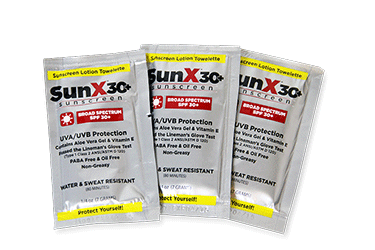
7) No Sunscreen Towelettes
FDA’s 2011 sunscreen rules ended the sale of sunscreen wipes and towelettes, but small companies have been granted another year to remove them from their product lines. One key question is whether you get enough sunscreen on your skin to ensure sun protection. EWG thinks these on-the-go packets are not worth the risk. So leave these and similar products on the shelf:
Sun X Sunscreen Towelettes, SPF 30+
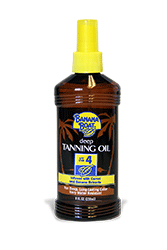
8) No Tanning Oils
Tanning oils are simply a bad idea. They promote risky behavior, encouraging users seek out intense sunshine that results in skin damage and increased risk of developing skin cancer.
Although some tanning oils contain sunscreen ingredients, the levels are always very low and offer little, if any, protection from the sun’s rays. Tanning oils are also associated with an increased danger of sunburn. Avoid products with SPF values lower than 15 or that don’t contain either zinc oxide or avobenzone for UVA protection, such as:
Banana Boat Deep Tanning Oil, SPF 4
No comments:
Post a Comment